Fuzzy Logic Method for Measuring Sustainable Decent Work Levels as a Corporate Social Responsibility Approach
Abstract
1. Introduction
- The design of a fuzzy logic method to define and quantify work conditions to determine the level of sustainable decent work as a CSR approach.
- The definition of the presence or absence of sustainable decent work using policies and laws relating to sustainability and safety and health in work.
- A proposed CSR approach tool that establishes a multivariable record for measuring and monitoring the level of sustainable decent work in the workplace.
2. Materials and Methods
2.1. Problem Description
2.2. Case Study
2.3. Phase I: Fuzzification
2.3.1. Defining Fuzzy Models and Fuzzy Sets
- Low level of risk—presence of SDW—environmental conditions, ergonomic factors, and organisation at work in workplaces which generate minimum fatigue or stress and lead to work-related illnesses in the long term—scored between 0 and 3;
- Medium level of risk—some presence of SDW—environmental conditions, ergonomic factors, and organisation at work in workplaces which generate fatigue and stress and lead to work-related illnesses in the medium term—scored between 2 and 7;
- High level of risk—absence of SDW—environmental conditions, ergonomic factors, and organisation at work in workplaces which generate extreme fatigue and stress and lead to work-related illnesses in the short term—scored between 6 and 10.
- Low level of risk—presence of SDW—noise less than 80 dB;
- Medium level of risk—some presence of SDW—noise between 80 dB and 90 dB;
- High level of risk—absence of SDW—noise higher than 90 dB.
- Low visual requirement: low level of risk—presence of SDW—lighting from 70 lux to 300 lux;
- Normal: medium level of risk—some presence of SDW—lighting from 200 lux to 750 lux;
- Demanding: high level of risk—absence of SDW—lighting higher than 500 lux.
- Cold: low level of risk—presence of SDW—heat stress from 10 °C and under to 23 °C;
- Thermal neutrality: medium level of risk—some presence of SDW—heat stress between 20 °C and 30 °C;
- Hot: high level of risk—absence of SDW—heat stress from 27 to 45 °C, considering that from values close to 40 °C, heat disorders begin to occur in humans.
- Low level of risk—presence of SDW—exposition time of 0 min to 80 min;
- Medium level of risk—some presence of SDW—exposition time between 60 min and 120 min;
- High level of risk—absence of SDW—exposition time of 100 min to 180 min or more.
- Low level of risk—presence of SDW—mass of 0 kg to 10 kg;
- Medium level of risk—some presence of SDW—mass between 7 kg and 15 kg;
- High level of risk—absence of SDW—mass of 13 kg to 25 kg or more.
- Low level of risk—presence of SDW—handling frequency of 0 movements to 700 movements;
- Medium level of risk—some presence of SDW—handling frequency between 600 movements and 1100 movements;
- High level of risk—absence of SDW—handling frequency of 900 to 1800 movements or more.
- Low level of risk—presence of SDW—workplace violence score of 0 points to 8 points;
- Medium level of risk—some presence of SDW—workplace violence score between 9 points and 12 points;
- High level of risk—absence of SDW—workplace violence score of more than 13 points.
- Low level of risk—presence of SDW—salary of more than USD 30 per day;
- Medium level of risk—some presence of SDW—salary between USD 12 and USD 30 per day;
- High level of risk—absence of SDW—salary of USD 6 to USD 12 per day.
- Low level of risk—presence of SDW—workday between 4 h and 8 h;
- Medium level of risk—some presence of SDW—workday between 7 h and 10 h;
- High level of risk—absence of SDW—workday between 9 h and 12 h or more.
2.3.2. Defining Linguistic Variables and Fuzzy Rules
- Variable → Environmental conditions. Linguistic variables → Noise, Lighting, and Heat_Stress;
- Variable → Ergonomic factors. Linguistic variables → Exposition_Time, Mass_Object, Lifting_Frequency;
- Variable → Organisation at work. Linguistic variables → Workplace_Violence, Salary, Workday;
- Membership function → absence of SDW;
- Membership function → some features of SDW;
- Membership function → presence of SDW.
2.4. Phase II: Defuzzification
Programming the Fuzzy Rules in the Fuzzy Logic Designer
3. Results
4. Discussion
5. Conclusions
Author Contributions
Funding
Institutional Review Board Statement
Informed Consent Statement
Data Availability Statement
Acknowledgments
Conflicts of Interest
Appendix A. Fuzzy Rules
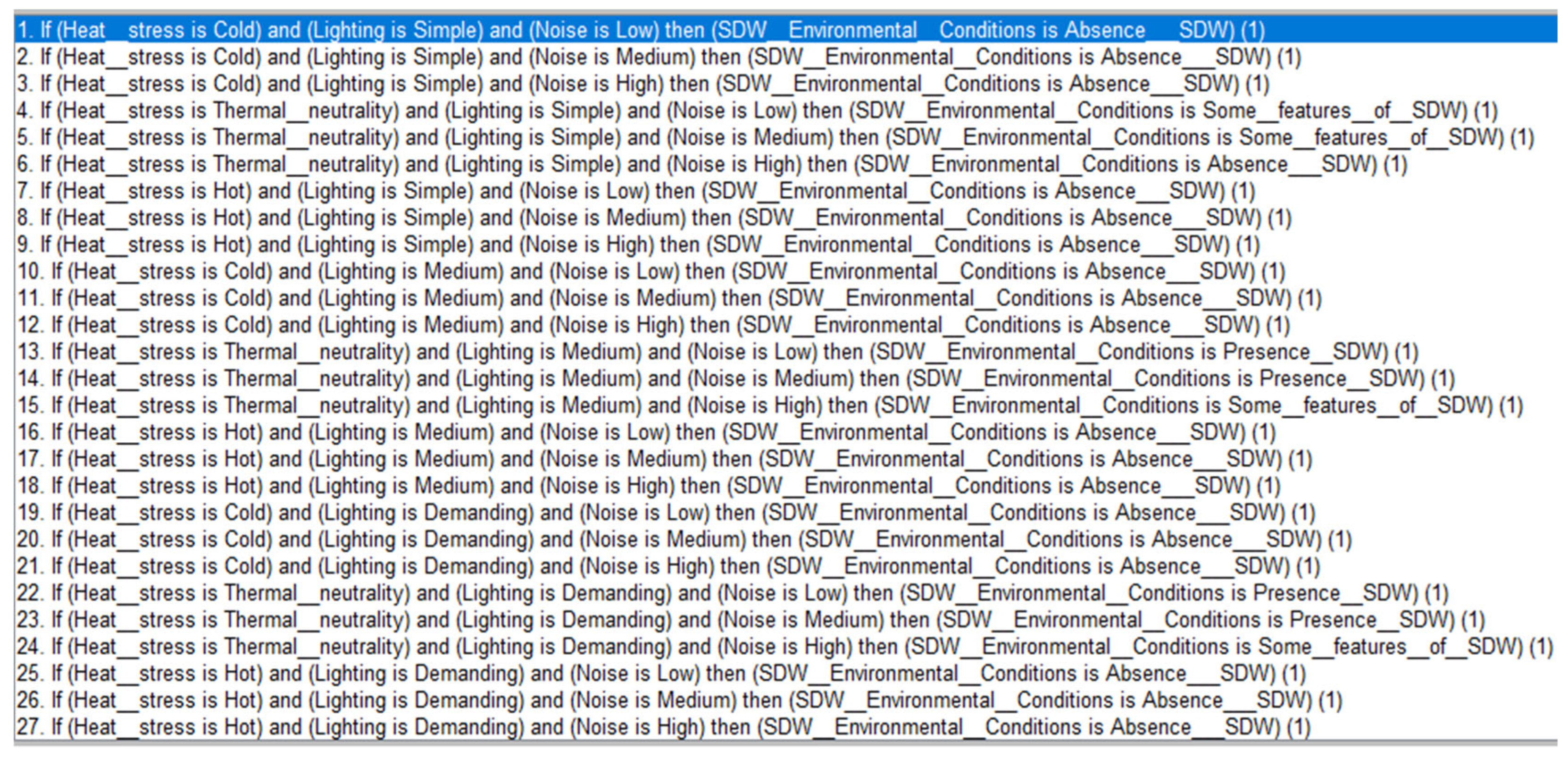

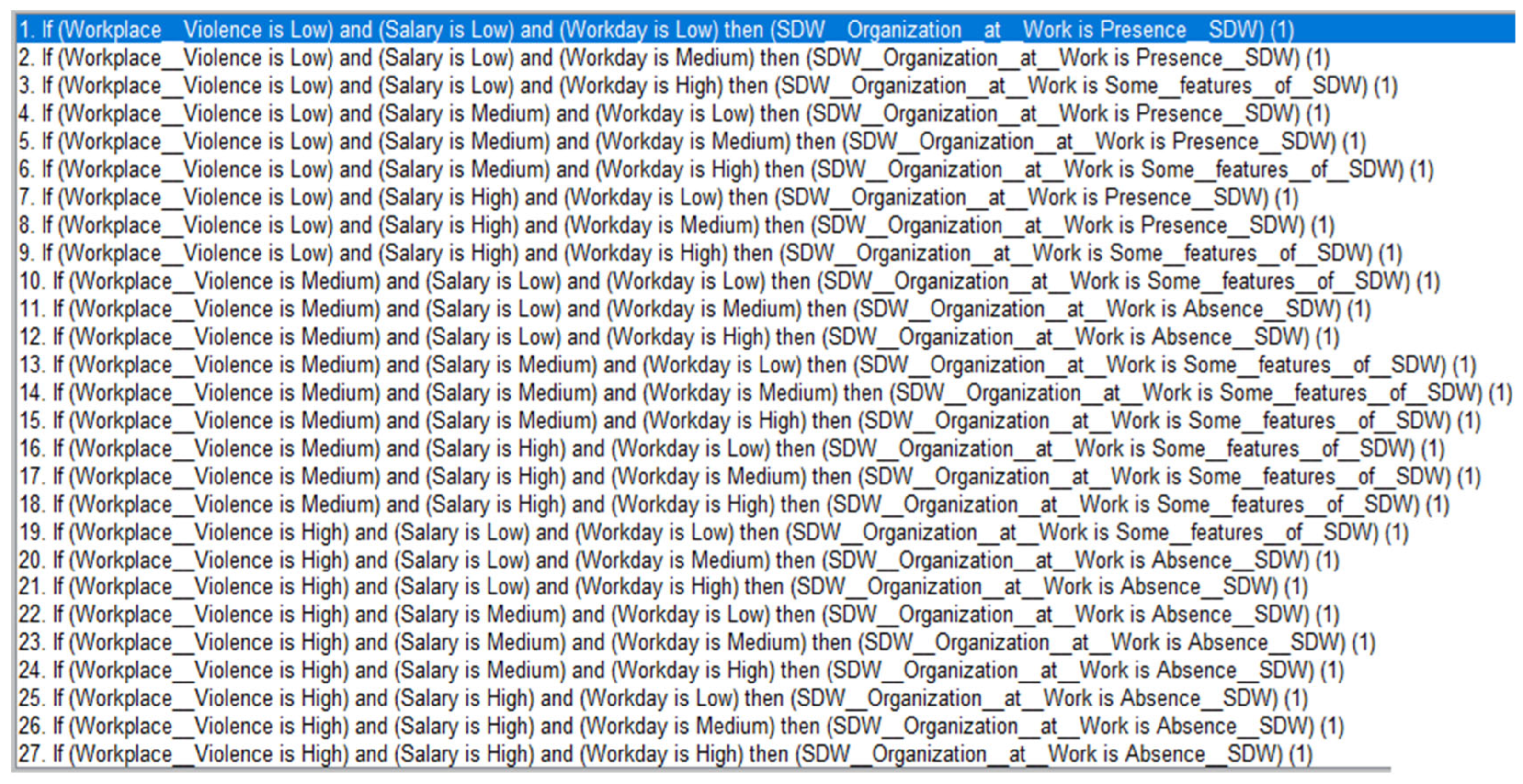
Appendix B. Examples of Evaluations by Department
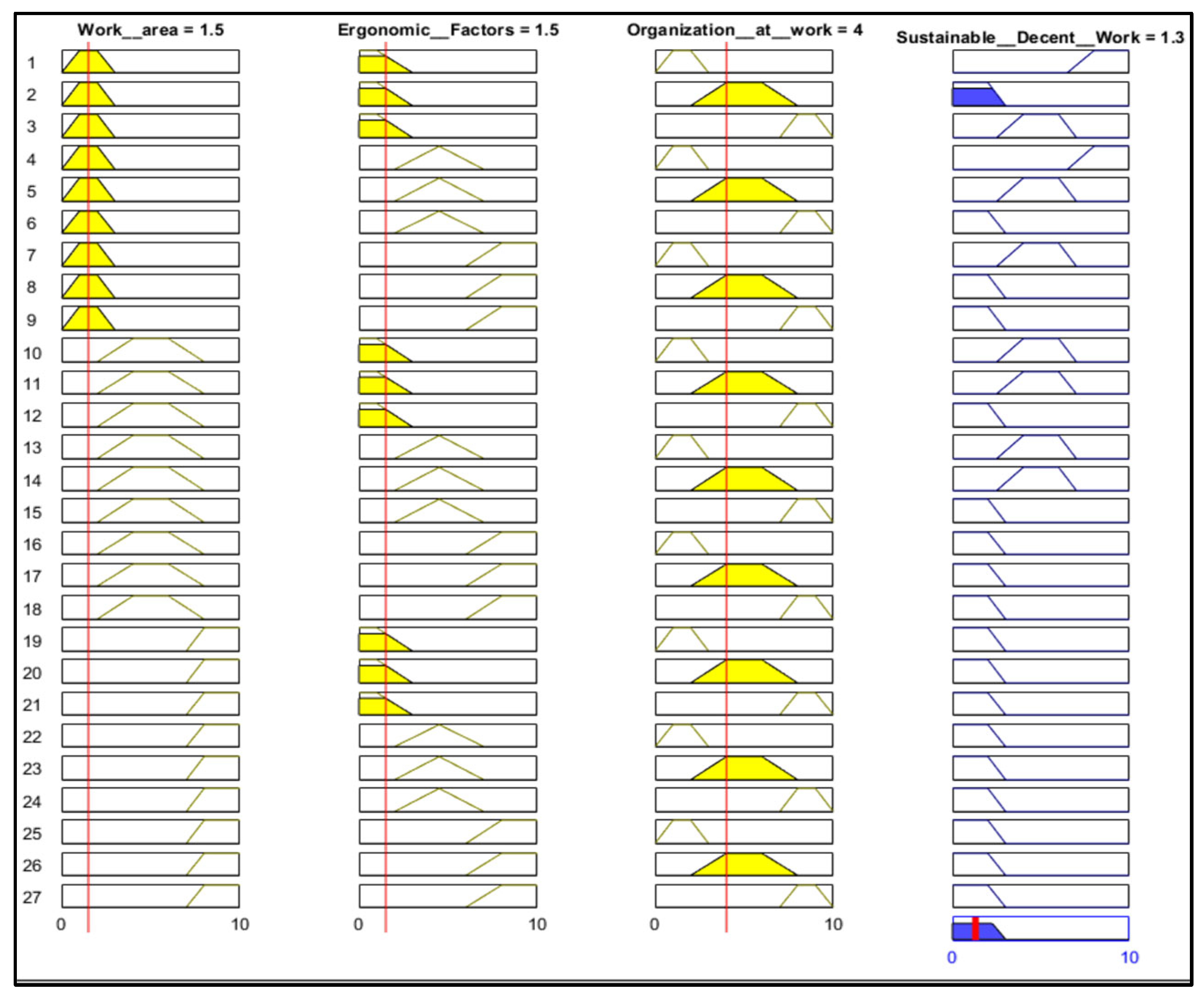
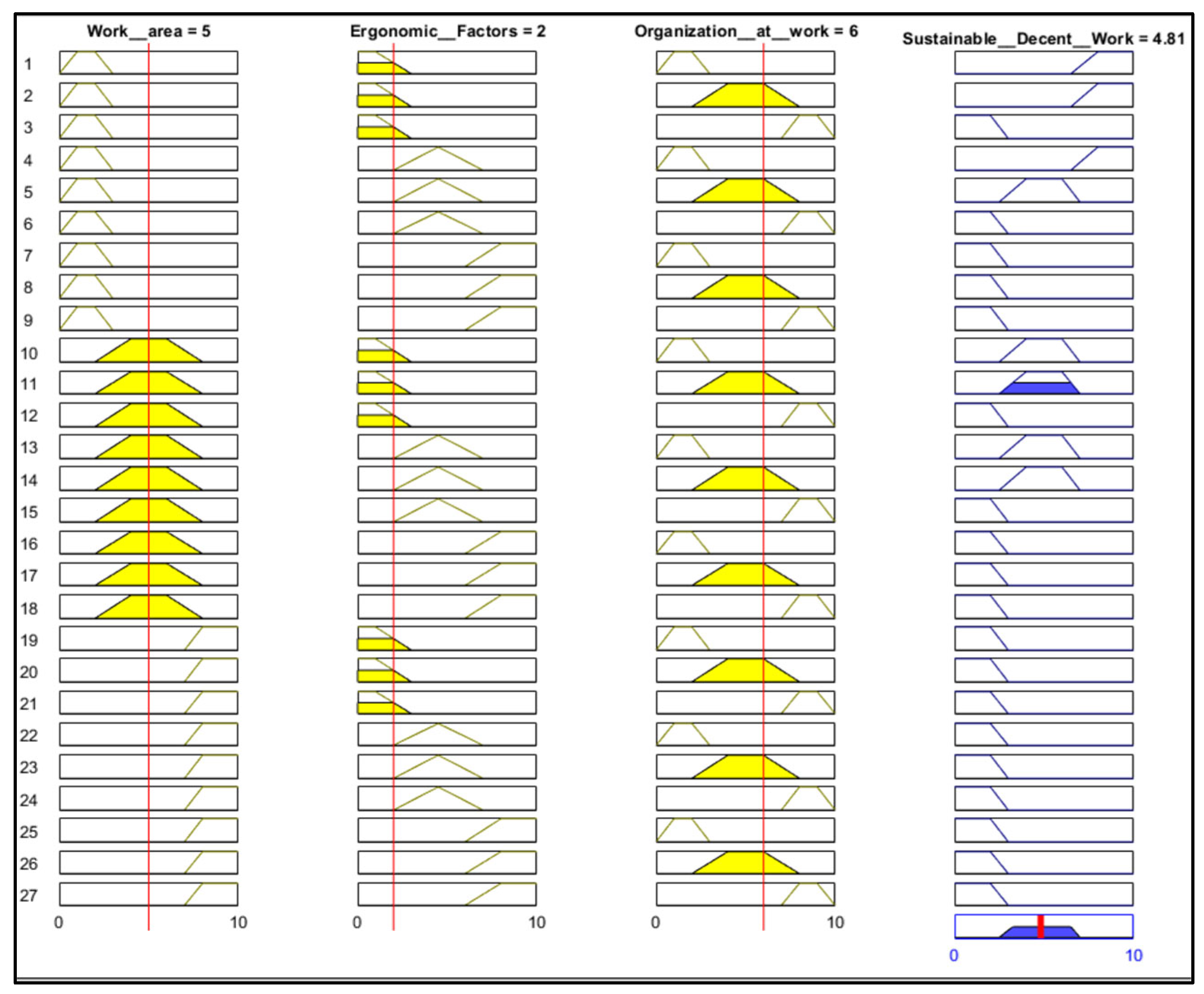
References
- Zadjafar, M.A.; Gholamian, M.R. A Sustainable Inventory Model by Considering Environmental Ergonomics and Environmental Pollution, Case Study: Pulp and Paper Mills. J. Clean. Prod. 2018, 199, 444–458. [Google Scholar] [CrossRef]
- Sánchez-Infante Hernández, J.P.; Yañez-Araque, B.; Moreno-García, J. Moderating Effect of Firm Size on the Influence of Corporate Social Responsibility in the Economic Performance of Micro-, Small- and Medium-Sized Enterprises. Technol. Forecast. Soc. Chang. 2020, 151, 119774. [Google Scholar] [CrossRef]
- Congress of the United Mexican States. Federal Labor Law of the United Mexican States; Diario Oficial de la Federación, CDMX: Mexico City, Mexico, 2024. [Google Scholar]
- Larrouyet, M.C. Desarrollo Sustentable: Origen, Evolución y Su Implementación Para el Cuidado del Planeta. Master’s Thesis, Universidad Nacional de Quilmes, Bernal, Argentina, 2015. [Google Scholar]
- Plata De Plata, D.; Plata Díaz, O. Ambiente, Economía, Tecnología y Sociedad: Componentes Clave Para El Desarrollo Sostenible. Multiciencias 2009, 9, 7–12. [Google Scholar]
- The United Nations. 17 Goals to Transform Our World. Available online: https://www.un.org/sustainabledevelopment/ (accessed on 24 November 2023).
- United Nations. Decent Work and Economic Growth: Why It Matters. Available online: https://www.un.org/sustainabledevelopment/wp-content/uploads/2018/09/Goal-8.pdf (accessed on 26 July 2023).
- United Nations. Goal 8 Decent Work and Economic Growth. Promote Inclusive and Sustainable Growth, Employment and Decent Work for All. Available online: https://www.un.org/sustainabledevelopment/economic-growth/ (accessed on 27 July 2023).
- Rodríguez, M. Gasto de Bolsillo y Gastos Catastróficos En Salud En Hogares Mexicanos. Carta Económica Reg. 2021, 0, 59–83. [Google Scholar] [CrossRef]
- Mensah, J. Sustainable Development: Meaning, History, Principles, Pillars, and Implications for Human Action: Literature Review. Cogent Soc. Sci. 2019, 5, 1653531. [Google Scholar] [CrossRef]
- Balderas, A.; Luna, E.; Voora, V.; Larrea, C. Voluntary Standards and Initiatives for Carbon Management: Navigating the Landscape; IISD: Winnipeg, MB, Canada, 2024. [Google Scholar]
- Barford, A.; Coombe, R.; Proefke, R. Against the Odds: Young People’s High Aspirations and Societal Contributions amid a Decent Work Shortage. Geoforum 2021, 121, 162–172. [Google Scholar] [CrossRef]
- Vignoli, E.; Prudhomme, N.; Terriot, K.; Cohen-Scali, V.; Arnoux-Nicolas, C.; Bernaud, J.L.; Lallemand, N. Decent Work in France: Context, Conceptualization, and Assessment. J. Vocat. Behav. 2020, 116, 103345. [Google Scholar] [CrossRef]
- Duffy, R.D.; Prieto, C.G.; Kim, H.J.; Raque-Bogdan, T.L.; Duffy, N.O. Decent Work and Physical Health: A Multi-Wave Investigation. J. Vocat. Behav. 2021, 127, 103544. [Google Scholar] [CrossRef]
- Yildirim, U.; Toygar, A.; Çolakoğlu, C. Compensation Effect of Wages on Decent Work: A Study on Seafarers Attitudes. Mar. Policy 2022, 143, 105155. [Google Scholar] [CrossRef]
- Lout, G.; Fitzpatrick, J.; Garcia Lozano, A.J.; Finkbeiner, E. Decent Work in a Seascape of Livelihoods: Regional Evaluation of the Shrimp and Groundfish Fishery of the Guianas-Brazil Shelf. Mar. Policy 2022, 144, 105231. [Google Scholar] [CrossRef]
- Yan, Y.; Geng, Y.; Gao, J. Measuring the Decent Work of Knowledge Workers: Constructing and Validating a New Scale. Heliyon 2023, 9, e17945. [Google Scholar] [CrossRef]
- International Labour Organizatio. Measurement of Decent Work: Discussion Paper for the Tripartite Meeting of Experts on the Measurement of Decent Work; International Labour Organizatio: Geneva, Switzerland, 2008. [Google Scholar]
- Raufflet, E.; Barin Cruz, L.; Bres, L. An Assessment of Corporate Social Responsibility Practices in the Mining and Oil and Gas Industries. J. Clean. Prod. 2014, 84, 256–270. [Google Scholar] [CrossRef]
- Kwon, H.; Park, Y. Proactive Development of Emerging Technology in a Socially Responsible Manner: Data-Driven Problem Solving Process Using Latent Semantic Analysis. J. Eng. Technol. Manag. 2018, 50, 45–60. [Google Scholar] [CrossRef]
- Hadj, T.B. Effects of Corporate Social Responsibility towards Stakeholders and Environmental Management on Responsible Innovation and Competitiveness. J. Clean. Prod. 2020, 250, 119490. [Google Scholar] [CrossRef]
- Ali, S.M.; Appolloni, A.; Cavallaro, F.; D’Adamo, I.; Di Vaio, A.; Ferella, F.; Gastaldi, M.; Ikram, M.; Kumar, N.M.; Martin, M.A.; et al. Development Goals towards Sustainability. Sustainability 2023, 15, 9443. [Google Scholar] [CrossRef]
- The MathWorks Inc. Fuzzy Logic Toolbox Diseñe y Simule Sistemas de Lógica Difusa. Available online: https://la.mathworks.com/products/fuzzy-logic.html (accessed on 19 July 2023).
- Nguyen, H.T.; Walker, C.L.; Walker, E.A. A First Curse in Fuzzy Logic, 4th ed.; CRC Press: Boca Raton, FL, USA; Taylor & Francis Group: New York, NY, USA, 2019. [Google Scholar]
- Klir, G.J.; Yuan, B. Fuzzy Sets and Fuzzy Logic. Theory and Applications, 1st ed.; Prentice Hall PTR: Hoboken, NJ, USA, 1995. [Google Scholar]
- Díaz-Contreras, C.A.; Aguilera-Rojas, A.; Guillén-Barrientos, N. Lógica Difusa vs. Modelo de Regresión Múltiple Para La Selección de Personal Fuzzy Logic vs. Multiple Regression for Selection Personnel. Ingeniare Rev. Chil. Ing. 2014, 22, 547–559. [Google Scholar] [CrossRef][Green Version]
- European Agency for Safety and Health at Work: An Introduction to Noise at Work. Factsheet 56—CE_2004_2169_EN.Indd. Available online: https://osha.europa.eu/sites/default/files/Factsheets_56_-_Informationen_zu_Larm_bei_der_Arbeit.pdf (accessed on 10 January 2024).
- Official Journal of the European Union. On the Minimum Health and Safety Requirements Regarding the Exposure of Workers to the Risks Arising from Physical Agents (Noise); Official Journal of the European Union: Brussels, Belgium, 2003; pp. 4238–4244. [Google Scholar]
- Secretaria del Trabajo y Previsión Social. NORMA Oficial Mexicana NOM-011-STPS-2001, Condiciones de Seguridad e Higiene En Los Centros de Trabajo Donde Se Genere Ruido; STPS (Secretarïa del Trabajo y Previsión Social): Ciudad de México, México, 2002. [Google Scholar]
- Suter, A.H. Noise. Standards and Regulations. In Encyclopaedia of Occupational Health and Safety—Part VI. General Hazards; International Labour Organization (ILO): Geneva, Switzerland, 2011; p. 47. [Google Scholar]
- Ministry of the Environment Government of Japan. Cabinet Order for Implementation of the Noise Regulation Law. Appendix I. Available online: https://www.env.go.jp/en/laws/air/noise/ap.html (accessed on 26 July 2023).
- Näf Cortés, R.R. Guía Práctica Para El Análisis y La Gestión Del Ruido Industrial, 1st ed.; FREMAP Government of Spain, Ed.; FREMAP Government of Spain: Madrid, Spain, 2013.
- Secretaría del Trabajo y Previsión Social. NORMA Oficial Mexicana NOM-025-STPS-2008, Condiciones de Iluminación En Los Centros de Trabajo; Diario Oficial de la Federación: Ciudad de México, México, 2008. [Google Scholar]
- Hernández Calleja, A.; Ramos Pérez, F. Lighting, Conditions Required for Visual Comfort. In Encyclopaedia of Occupational Health and Safety—Part VI. General Hazards; International Labour Organization (ILO): Geneva, Switzerland, 2011; p. VI. [Google Scholar]
- Ministry of Health, Labour and Welfare. Ordinance on Industrial Safety and Health; Ministry of Health, Labour and Welfare: Tokyo, Japan, 2006. Available online: https://www.japaneselawtranslation.go.jp/en/laws/view/3878/en#je_pt3ch5 (accessed on 10 January 2024).
- Parsons, K.C. Heat and Cold. Assessment of Heat Stress and Heat Stress Indices. In Encyclopaedia of Occupational Health and Safety—Part VI. General Hazards; International Labour Organization (ILO): Geneva, Switzerland, 2011; p. 42. [Google Scholar]
- Secretaría del Trabajo y Previsión Social. NORMA Oficial Mexicana NOM-015-STPS-2001, Condiciones Térmicas Elevadas o Abatidas-Condiciones de Seguridad e Higiene; Diario Oficial de la Federación: Ciudad de México, México, 2001. [Google Scholar]
- ISO 11228-1:2021(E); Ergonomics-Manual Handling—Part 1: Lifting, Lowering and Carrying. International Standard Organization—ISO: Geneva, Switzerland, 2021.
- Contreras-Valenzuela, M.R.; Seuret-Jiménez, D.; Hdz-Jasso, A.M.; León Hernández, V.A.; Abundes-Recilla, A.N.; Trutié-Carrero, E. Design of a Fuzzy Logic Evaluation to Determine the Ergonomic Risk Level of Manual Material Handling Tasks. Int. J. Environ. Res. Public Health 2022, 19, 6511. [Google Scholar] [CrossRef]
- Secretaría del Trabajo y Previsión Social. NORMA Oficial Mexicana NOM-035-STPS-2018, Factores de Riesgo Psicosocial en el Trabajo-Identificación, Análisis y Prevención; STPS: Mexico City, Mexico, 2018. [Google Scholar]
- Ghasemi, F.; Mahdavi, N. A New Scoring System for the Rapid Entire Body Assessment (REBA) Based on Fuzzy Sets and Bayesian Networks. Int. J. Ind. Ergon. 2020, 80, 103058. [Google Scholar] [CrossRef]
- Parra-Domínguez, J.; Alonso-García, M.; Corchado, J.M. Fuzzy Logic to Measure the Degree of Compliance with a Target in an SDG—The Case of SDG 11. Mathematics 2023, 11, 2967. [Google Scholar] [CrossRef]
- Neumann, W.P.; Ekman, M.; Winkel, J. Integrating Ergonomics into Production System Development—The Volvo Powertrain Case. Appl. Ergon. 2009, 40, 527–537. [Google Scholar] [CrossRef] [PubMed]
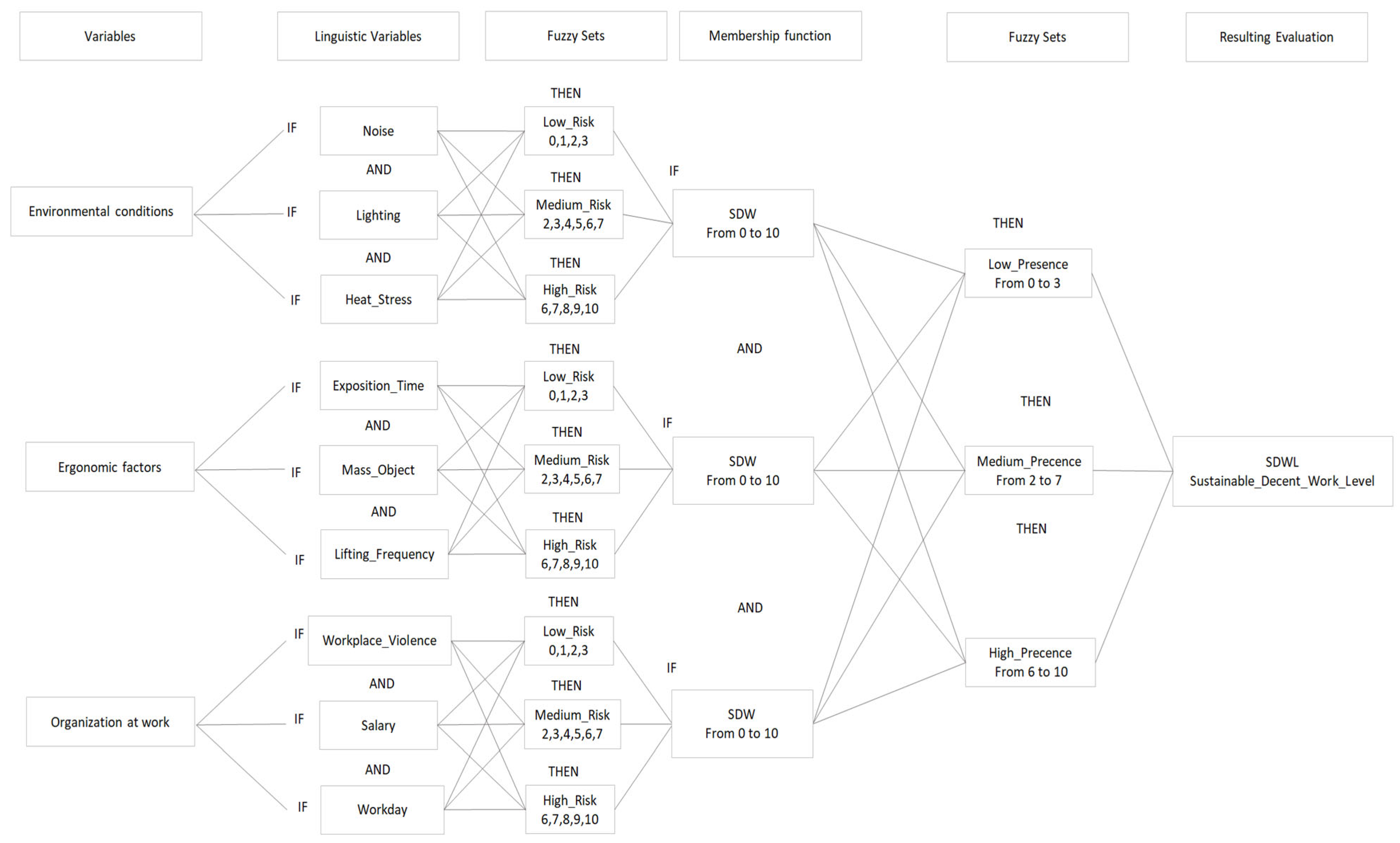
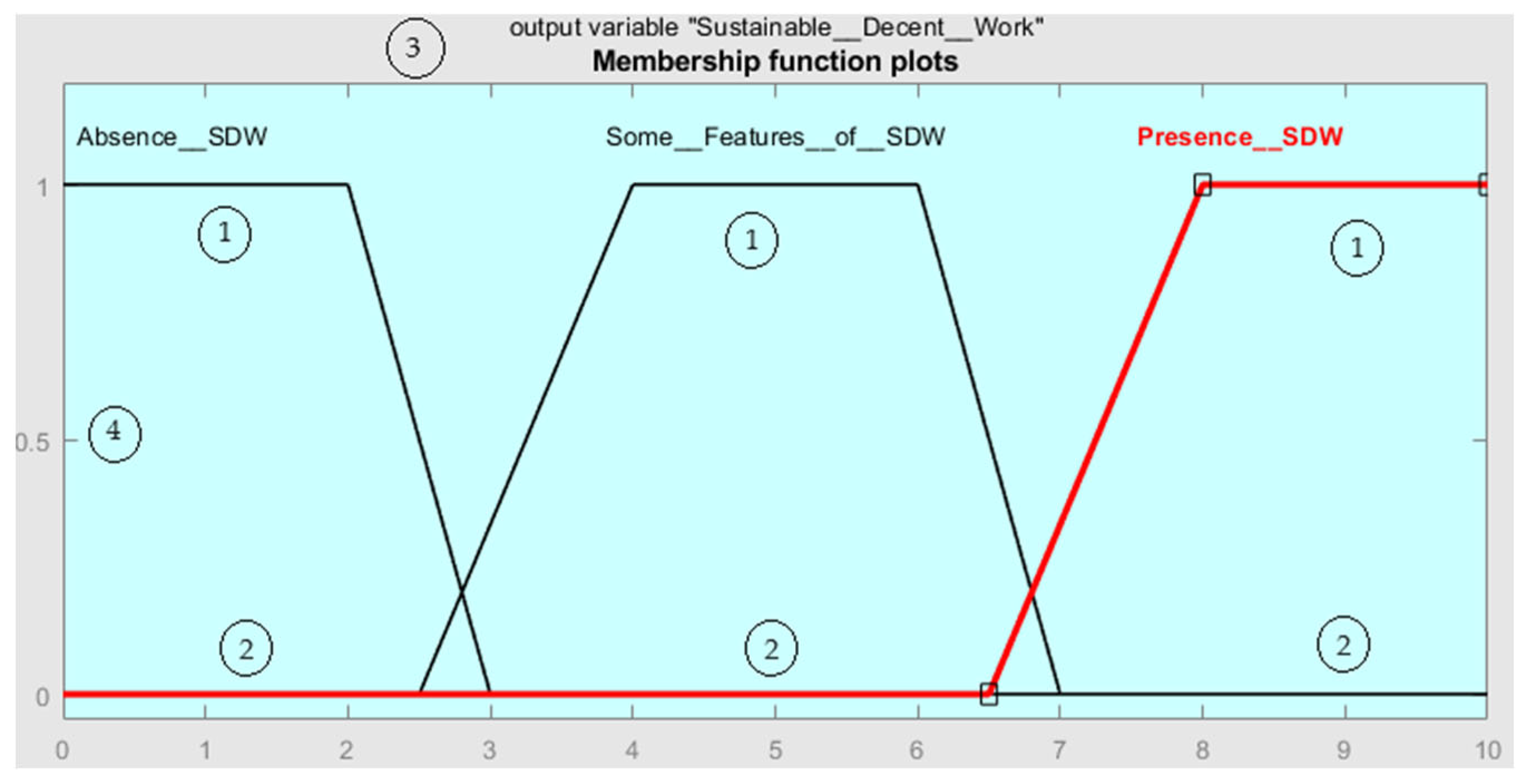

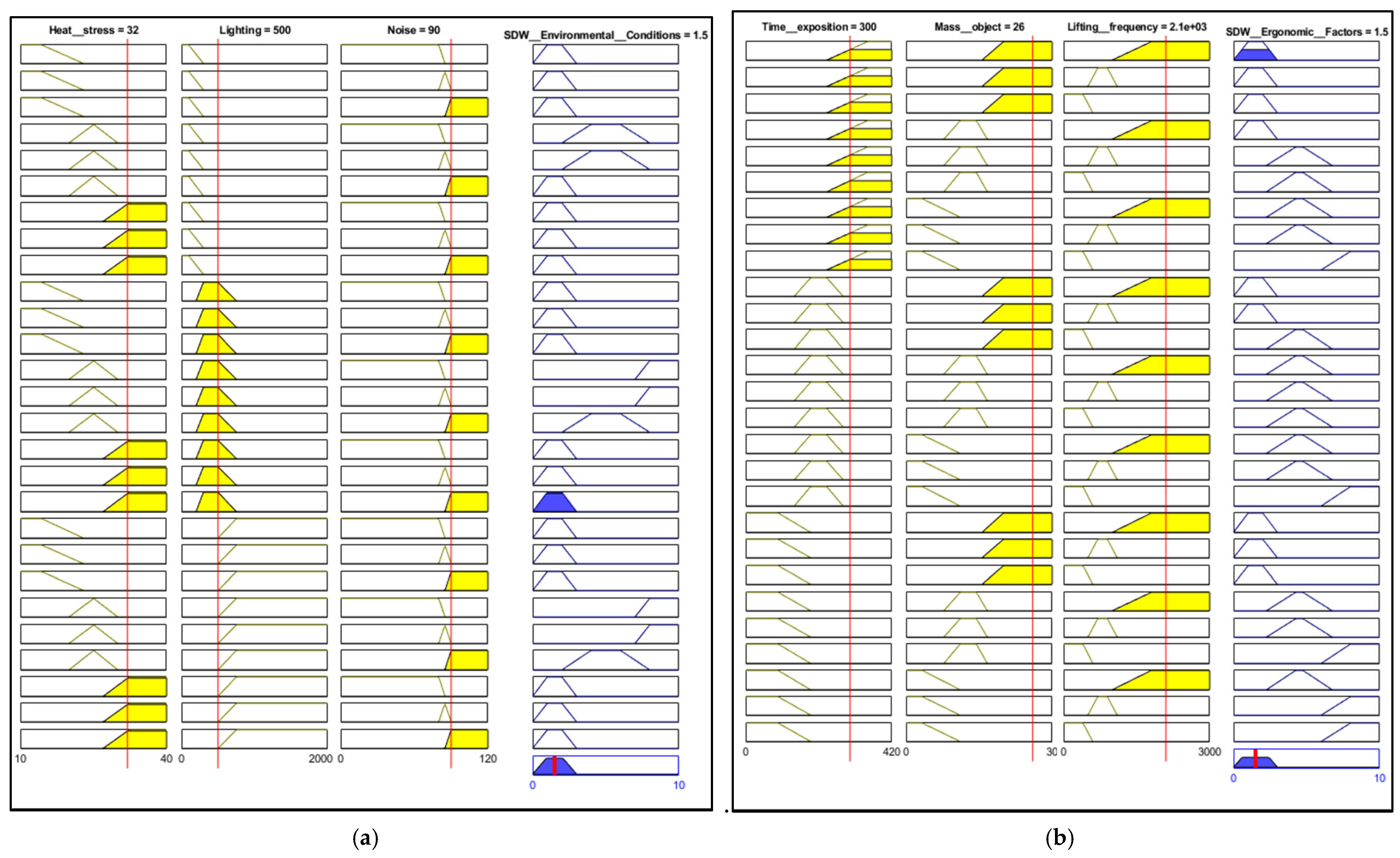
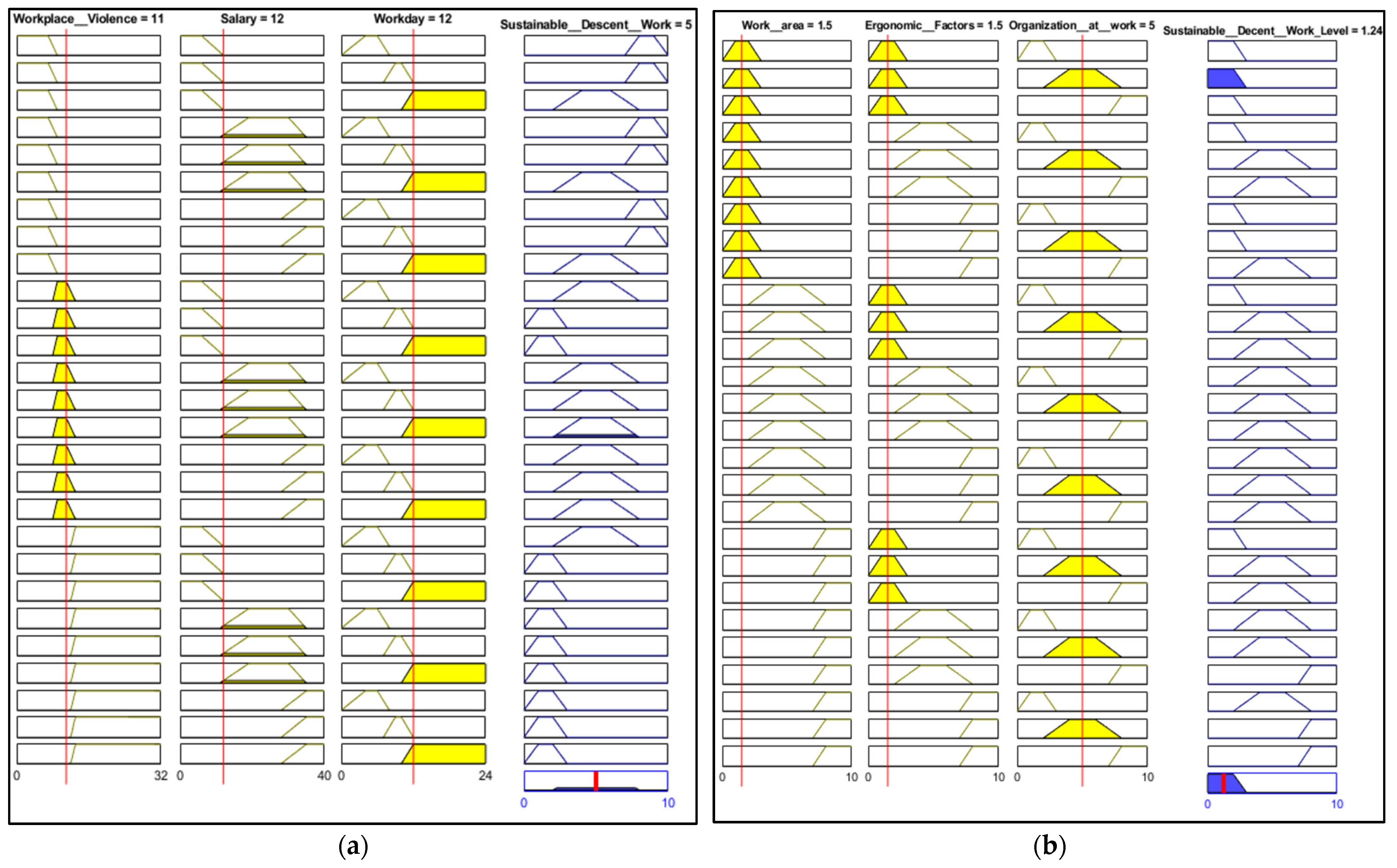
| Environmental Conditions | Ergonomic Factors | Organisation at Work | ||||||||||
|---|---|---|---|---|---|---|---|---|---|---|---|---|
| IF | IF | IF | IF | IF | IF | IF | IF | IF | ||||
| AND | AND | THEN | AND | AND | THEN | AND | AND | THEN | ||||
| Rule No. | Noise | Lighting | Heat_Stress | SWD Risk | Exposition_Time | Mass_Object | Lifting_Frequency | SDW Risk | Workplace_Violence | Salary | Workday | SDW Risk |
| 1 | Low | Low | Low | Absence | High | High | High | Absence | Low | Low | Low | Some |
| 2 | Medium | Low | Low | Absence | High | High | Medium | Absence | Low | Low | Medium | Some |
| 3 | High | Low | Low | Absence | High | High | Low | Absence | Low | Low | High | Absence |
| 4 | Low | Low | Medium | Some | High | Medium | High | Absence | Low | Medium | Low | Presence |
| 5 | Medium | Low | Medium | Some | High | Medium | Medium | Absence | Low | Medium | Medium | Presence |
| 6 | High | Low | Medium | Absence | High | Medium | Low | Absence | Low | Medium | High | Some |
| 7 | Low | Low | High | Absence | High | Low | High | Absence | Low | High | Low | Presence |
| 8 | Medium | Low | High | Absence | High | Low | Medium | Some | Low | High | Medium | Presence |
| 9 | High | Low | High | Absence | High | Low | Low | Presence | Low | High | High | Presence |
| 10 | Low | Medium | Low | Absence | Medium | High | High | Absence | Medium | Low | Low | Absence |
| 11 | Medium | Medium | Low | Absence | Medium | High | Medium | Absence | Medium | Low | Medium | Absence |
| 12 | High | Medium | Low | Absence | Medium | High | Low | Some | Medium | Low | High | Absence |
| 13 | Low | Medium | Medium | Presence | Medium | Medium | High | Some | Medium | Medium | Low | Absence |
| 14 | Medium | Medium | Medium | Presence | Medium | Medium | Medium | Some | Medium | Medium | Medium | Absence |
| 15 | High | Medium | Medium | Some | Medium | Medium | Low | Some | Medium | Medium | High | Absence |
| 16 | Low | Medium | High | Absence | Medium | Low | High | Some | Medium | High | Low | Absence |
| 17 | Medium | Medium | High | Absence | Medium | Low | Medium | Some | Medium | High | Medium | Absence |
| 18 | High | Medium | High | Absence | Medium | Low | Low | Presence | Medium | High | High | Absence |
| 19 | Low | High | Low | Absence | Low | High | High | Some | High | Low | Low | Absence |
| 20 | Medium | High | Low | Absence | Low | High | Medium | Some | High | Low | Medium | Absence |
| 21 | High | High | Low | Absence | Low | High | Low | Presence | High | Low | High | Absence |
| 22 | Low | High | Medium | Presence | Low | Medium | High | Some | High | Medium | Low | Absence |
| 23 | Medium | High | Medium | Presence | Low | Medium | Medium | Some | High | Medium | Medium | Absence |
| 24 | High | High | Medium | Some | Low | Medium | Low | Presence | High | Medium | High | Absence |
| 25 | Low | High | High | Absence | Low | Low | High | Presence | High | High | Low | Absence |
| 26 | Medium | High | High | Absence | Low | Low | Medium | Presence | High | High | Medium | Absence |
| 27 | High | High | High | Absence | Low | Low | Low | Presence | High | High | High | Absence |
| Departments | ||||||||
|---|---|---|---|---|---|---|---|---|
| Linguistic Variables | Membership Functions | Ranks | Laminating | Tempering | Post Glass | Supply Chain | Quality Control | Total |
| Noise | Low_Risk | <80 db | 2 | 10 | 0 | 1 | 13 | |
| Medium_Risk | 80–90 db | 39 | 35 | 16 | 10 | 100 | ||
| High_Risk | >90 db | 6 | 2 | 0 | 1 | 9 | ||
| Lighting | Low_Risk | 70–300 lux | 43 | 55 | 42 | 0 | 1 | 42 |
| Medium_Risk | 200–750 lux | 92 | 91 | 7 | 49 | 23 | 262 | |
| High_Risk | >600 lux | 0 | 0 | 0 | 0 | 0 | ||
| Heat_Stress | Low_Risk | 10–23 °C | 0 | 0 | 0 | 10 | 10 | |
| Medium_Risk | 20–30 °C | 7 | 10 | 0 | 40 | 57 | ||
| High_Risk | 27–45 °C | 15 | 8 | 50 | 3 | 25 | 101 | |
| Total | 594 | |||||||
| Question | Questions Answered with “Yes” | Questions Answered with “No” | Unanswered Question for Fear of Reprisals |
|---|---|---|---|
| 78 | 188 | 45 |
| 86 | 180 | 45 |
| 169 | 97 | 45 |
| 185 | 81 | 45 |
| 150 | 116 | 45 |
| 223 | 43 | 45 |
| 43 | 233 | 45 |
| 105 | 161 | 45 |
| 9 | 246 | 45 |
| 18 | 267 | 45 |
| Workstation | Environmental Conditions | Ergonomics Factors | Organisation at Work | SDWL | Results |
|---|---|---|---|---|---|
| 1 Laminating | 5 | 5 | 5 | 5.84 | Some features of SDW |
| 2 Laminating | 3 | 6 | 7 | 5.8 | Some features of SDW |
| 3 Laminating | 7 | 4 | 5 | 5.81 | Some features of SDW |
| 4 Laminating | 8 | 6 | 8 | 1.78 | Absence of SDW |
| 5 Laminating | 7 | 4 | 7.5 | 3.23 | Absence of SDW |
| 6 Laminating | 7 | 6 | 5 | 5.8 | Some features of SDW |
| 7 Laminating | 4 | 4 | 4 | 5.84 | Some features of SDW |
| 8 Quality Control | 8 | 3 | 8 | 1.78 | Absence of SDW |
| 9 Quality Control | 8 | 3 | 3 | 5.8 | Some features of SDW |
| 10 Quality Control | 8 | 2 | 2 | 8.84 | Presence of SDW |
| 11 Quality Control | 10 | 1 | 1 | 8.9 | Presence of SDW |
| 12 Quality Control | 7 | 3 | 3 | 5.8 | Some features of SDW |
| 13 Quality Control | 7 | 2 | 2 | 5.81 | Some features of SDW |
| 14 Supply Chain | 1.5 | 7.69 | 1.5 | 1.59 | Absence of SDW |
| 15 Supply Chain | 4.53 | 3.79 | 4.03 | 5.83 | Some features of SDW |
| 16 Supply Chain | 4 | 1.34 | 5 | 5.84 | Some features of SDW |
| 17 Supply Chain | 4.04 | 2.38 | 5.67 | 5.79 | Some features of SDW |
| 18 Tempering | 2.35 | 1.06 | 3.38 | 2.69 | Absence of SDW |
| 19 Tempering | 1.5 | 3.85 | 7.32 | 1.81 | Absence of SDW |
| 20 Tempering | 5 | 7.12 | 8.5 | 1.71 | Absence of SDW |
| 21 Tempering | 8.69 | 8.22 | 1.5 | 1.53 | Absence of SDW |
| 22 Tempering | 3.45 | 4.5 | 1.5 | 5.83 | Some features of SDW |
| 23 Tempering | 2.35 | 1.24 | 5 | 2.69 | Absence of SDW |
| 24 Tempering | 8.74 | 6.63 | 3.5 | 3.2 | Absence of SDW |
| 25 Post Glass | 3.48 | 1.4 | 4 | 5.83 | Some features of SDW |
| 26 Post Glass | 8.69 | 1.24 | 6.5 | 8.87 | Presence of SDW |
| 27 Post Glass | 1.5 | 3.88 | 7 | 1.74 | Absence of SDW |
| 28 Post Glass | 5 | 1.06 | 8.5 | 1.54 | Absence of SDW |
| 29 Post Glass | 8 | 2.35 | 1.5 | 8.82 | Presence of SDW |
| 30 Post Glass | 7 | 8.47 | 3 | 1.74 | Absence of SDW |
| 31 Post Glass | 3.5 | 1.07 | 1.5 | 5.84 | Some features of SDW |
| 32 Post Glass | 2.3 | 8.23 | 5 | 1.65 | Absence of SDW |
| 33 Post Glass | 1.5 | 3.85 | 2.32 | 1.81 | Absence of SDW |
Disclaimer/Publisher’s Note: The statements, opinions and data contained in all publications are solely those of the individual author(s) and contributor(s) and not of MDPI and/or the editor(s). MDPI and/or the editor(s) disclaim responsibility for any injury to people or property resulting from any ideas, methods, instructions or products referred to in the content. |
© 2024 by the authors. Licensee MDPI, Basel, Switzerland. This article is an open access article distributed under the terms and conditions of the Creative Commons Attribution (CC BY) license (https://creativecommons.org/licenses/by/4.0/).
Share and Cite
Abundes-Recilla, A.N.; Seuret-Jiménez, D.; Contreras-Valenzuela, M.R.; Nieto-Jalil, J.M. Fuzzy Logic Method for Measuring Sustainable Decent Work Levels as a Corporate Social Responsibility Approach. Sustainability 2024, 16, 1791. https://doi.org/10.3390/su16051791
Abundes-Recilla AN, Seuret-Jiménez D, Contreras-Valenzuela MR, Nieto-Jalil JM. Fuzzy Logic Method for Measuring Sustainable Decent Work Levels as a Corporate Social Responsibility Approach. Sustainability. 2024; 16(5):1791. https://doi.org/10.3390/su16051791
Chicago/Turabian StyleAbundes-Recilla, Alma Nataly, Diego Seuret-Jiménez, Martha Roselia Contreras-Valenzuela, and José M. Nieto-Jalil. 2024. "Fuzzy Logic Method for Measuring Sustainable Decent Work Levels as a Corporate Social Responsibility Approach" Sustainability 16, no. 5: 1791. https://doi.org/10.3390/su16051791
APA StyleAbundes-Recilla, A. N., Seuret-Jiménez, D., Contreras-Valenzuela, M. R., & Nieto-Jalil, J. M. (2024). Fuzzy Logic Method for Measuring Sustainable Decent Work Levels as a Corporate Social Responsibility Approach. Sustainability, 16(5), 1791. https://doi.org/10.3390/su16051791









